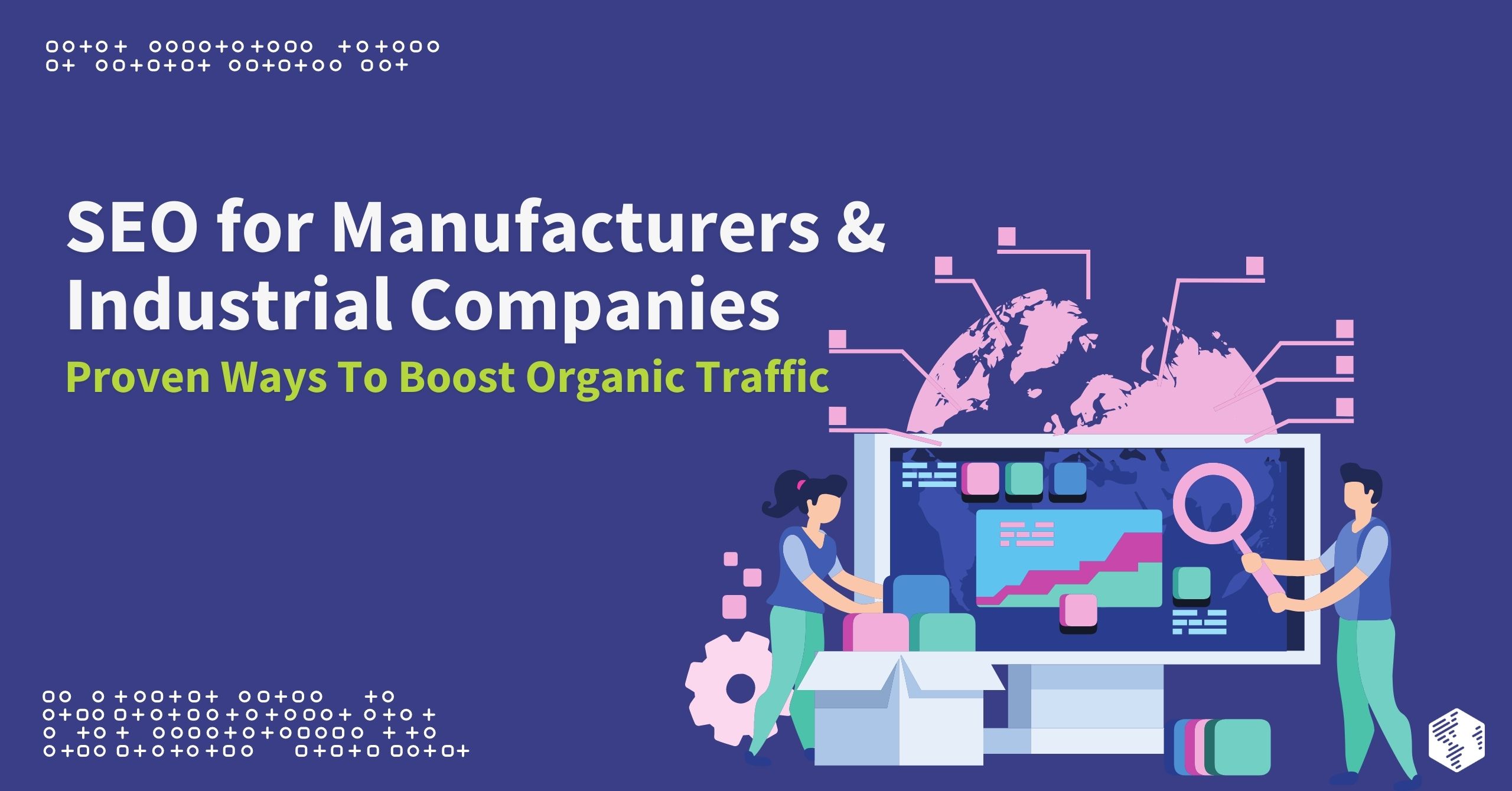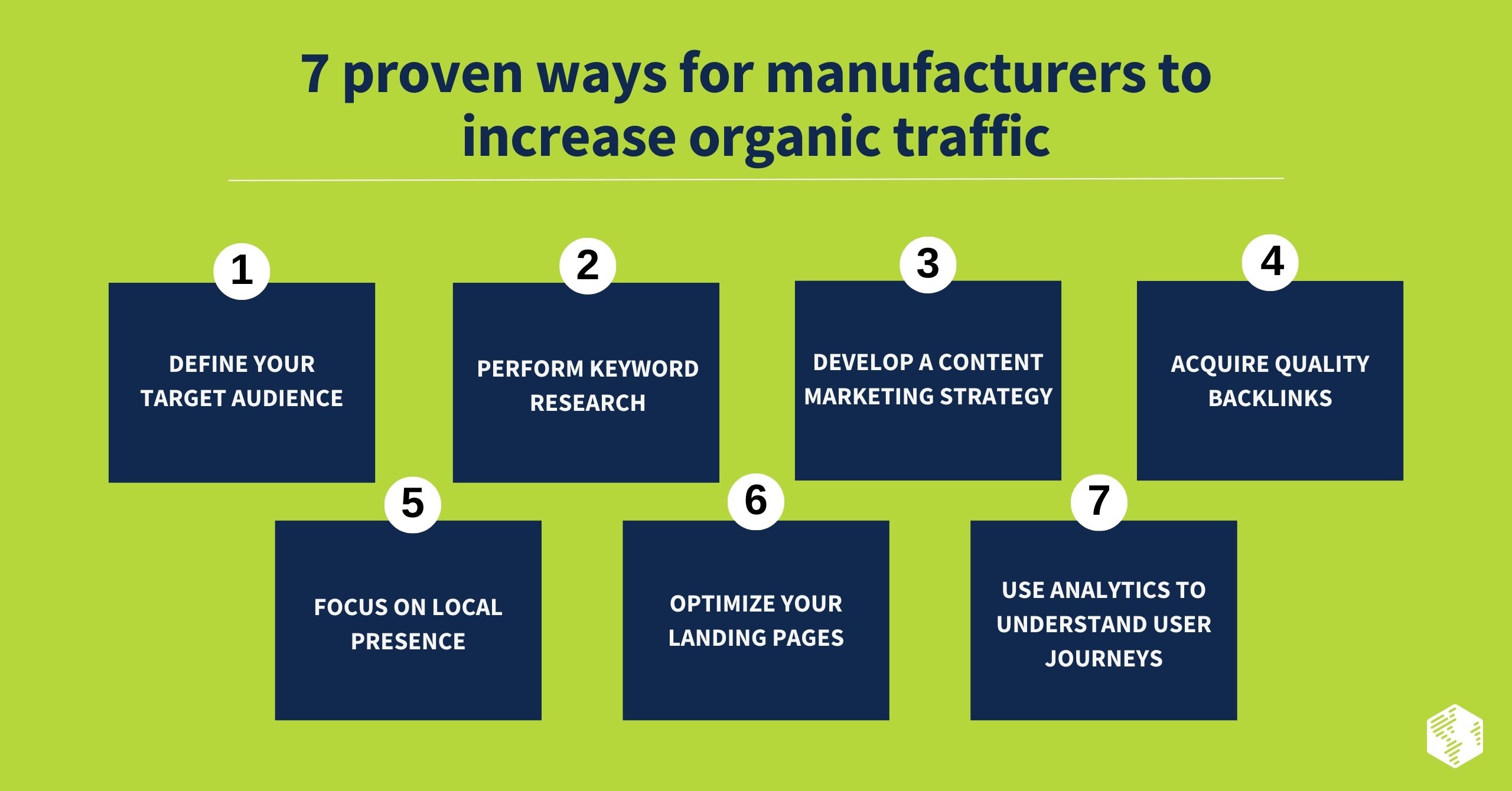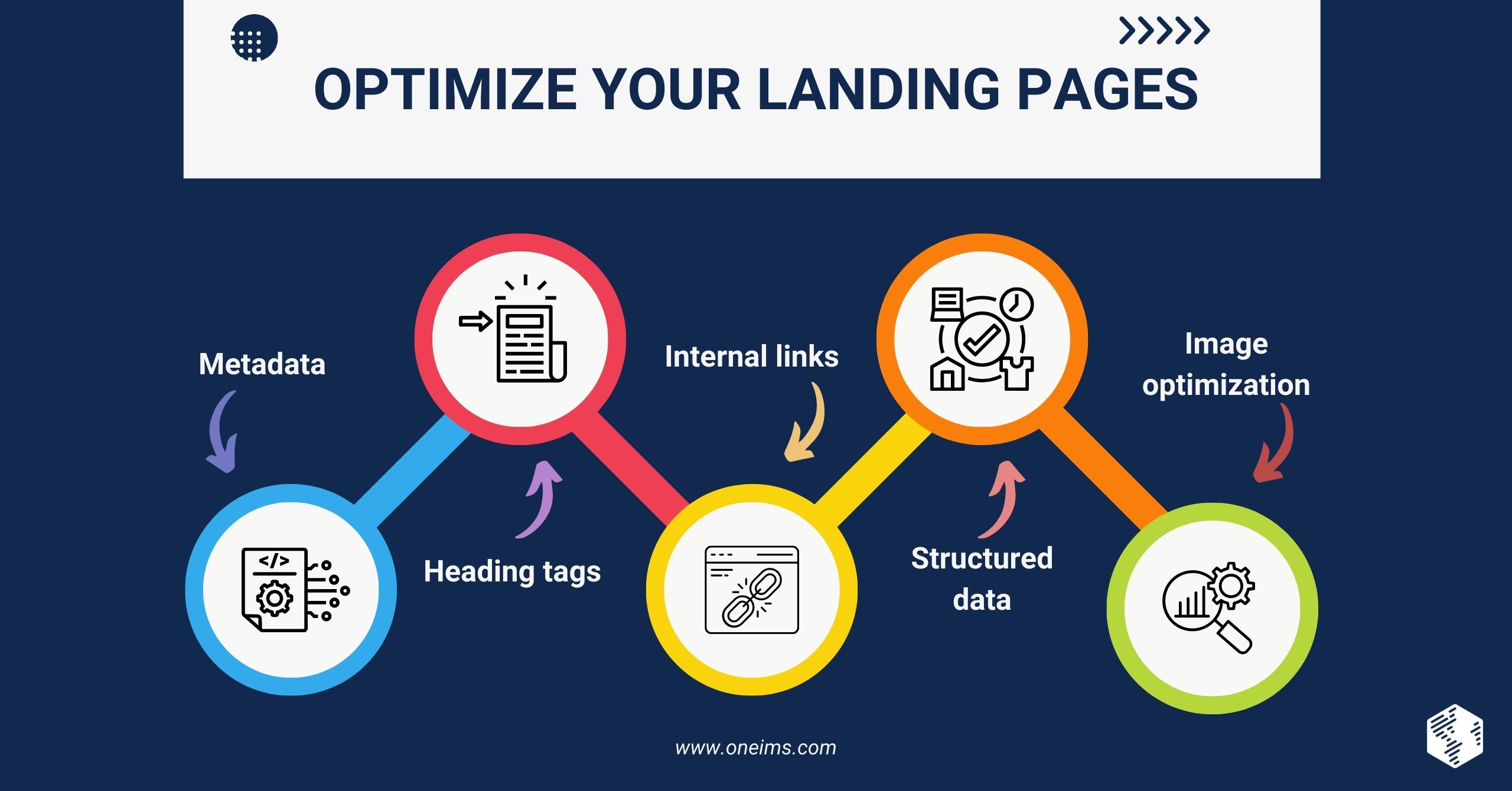Search engine optimization (SEO) is seen mainly as a B2C marketing tactic designed to attract the eye of the end-consumer, convert them, and retain them. However, just because it’s primarily lauded as a B2C tactic doesn’t mean that B2B companies cannot benefit from it.
SEO for manufacturers and industrial companies can be surprisingly more powerful than any PR strategy and inspire more trust than any word-of-mouth campaign. It increases your brand’s reach, improves the site visitor’s experience, and allows you to build up an impeccable reputation. Admittedly, it can only do this and more if you develop the right strategies for success.
So, let’s get to work and learn how you can ensure that SEO for industrial companies delivers the results you’re after.
What is manufacturing SEO?
Manufacturing SEO doesn’t differ much from any other type of search engine optimization. It’s the not-so-simple process of streamlining your website to make it more visible and beneficial to your visitors.
In a nutshell, manufacturing SEO helps you improve your website so that it ranks higher on the search engine results pages (SERPs) than the competitors.
Many businesses mistakenly believe ranking higher means stuffing their websites with barely sensical keywords. Keywords their audiences would use when searching for relevant products and services online – such as “apparel manufacturing in the US,” “electronic equipment manufacturing companies,” and the like.
The result of this is low-quality website content that solely leads to user frustration and Google penalties.
SEO for manufacturing and industrial companies is so much more than keyword stuffing. It involves making your site fast and mobile-friendly, optimizing your content, improving the overall user experience, and above all else, delivering value to all visitors.
Why is SEO important for industrial companies?
Primarily, SEO for manufacturing and industrial companies is critical as it increases your website’s visibility, as discussed. The better your SEO practices, the higher your site will rank on the SERPs, and the more likely it will be for your target audience to notice it.
However, it’s not all solely about becoming more visible. Securing one of the top spots on SERPs brings countless benefits. The biggest of them all is the reputation that follows the top ranking.
Search engines like Google enjoy a pristine reputation among the general audiences, and when they rank your site higher than others in their SERPs, they are essentially vouching for you. Thus, their excellent reputation brushes off on your brand.
Additionally, a higher ranking also works to establish you as the leader in your industry. It indicates that you are an excellent source of relevant information, reliable, and trustworthy – all factors the key decision-makers consider when searching for a B2B brand to partner with.
7 proven ways for manufacturers to increase organic traffic
Admittedly, increasing organic traffic through industrial SEO marketing isn’t a simple task. Search engines have complex algorithms that determine your ranking for any given search term, taking into account the keywords you’re using on the site, your page loading speed, the use of different media types, and more.
All this is to say that search engine optimization is an ongoing process that requires the utmost dedication. To simplify it, you must know what you’re doing and why.
The following are the most effective ways to increase organic traffic to your website and win at search engine optimization.
1. Define your target audience
Like any other marketing tactic, SEO requires thorough audience research. You need to understand what your audience is after if you’re to provide it to them.
Now, B2C brands tend to have an easier time defining their target audience for SEO as they address only one decision-maker through their marketing – the end buyer. B2B brands need to address several decision-makers simultaneously, from procurement officers to managers, directors, and even CEOs at times. Depending on the specific business, you might have to address over ten decision-makers in your SEO campaigns.
The simplest way to approach this task is by creating a streamlined buyer’s journey and developing SEO content that fits each step.
Thorough audience analysis will give you insights into the number and type of decision-makers you’ll encounter, their main concerns and pain points, and their interests and desires. From there, you can go on to create content that resonates with each person who begins on your buyer’s journey.
READ: 7 Key Marketing Challenges in the Manufacturing Industry (and How to Solve Them)
2. Perform keyword research
The next step is performing keyword research. Put plainly – keywords are the terms your audience will likely use when looking up products or services in your industry. They can sometimes be generic, such as “apparel manufacturing in the US.” However, they are rarely so in B2B environments. Still, regardless of how generic or specific they are, the right keywords need to be present on your website to boost your visibility and increase conversions.
As previously mentioned, you’ll want to avoid keyword stuffing – aka filling your website with common search terms without delivering value. However, you’ll still need to use the right keywords in your content to get the attention of the right audiences. That means using the keywords as a starting point to develop content that delivers value to your audience.
Though thorough audience research will often shed light on the keywords you should focus on, you should still adopt approaches such as social listening to better understand the words you need to use to rank higher on SERPs.
3. Develop a content marketing strategy
With a complete understanding of your target audience and what keywords they’re using to search for products and services in your industry, it’s time for the next step. You’ll need to start developing a comprehensive content marketing strategy.
Content comes in many shapes and forms. Detailed FAQ pages can serve as an excellent type of content that allows you to use your keywords naturally and offer valuable information to your website visitors.
Case studies are another great example, as they allow you to highlight your brand’s unique selling points. User reviews, client testimonials, eBooks, and more can all work wonders for improving your SEO. However, the king of all content types are blog posts.
Well-thought-out blog posts enable you to go into detail on any given topic that concerns your visitors, simultaneously allowing you to display your expertise.
The key to creating blog posts that improve awareness and conversions is developing a content marketing calendar and sticking to it. Publish frequent, relevant posts that keep your readers informed and entertained.
4. Acquire quality backlinks
Backlinks, or inbound links, lead from one website back to yours. Though a relatively simple, straightforward concept, they are essential to your SEO efforts.
When other high-authority websites link back to your own, it indicates to search engines that you have valuable content. The type of content that deserves a higher ranking. The more high-authority websites lead back to your own, the more trustworthy you’ll appear – both to search engines and your target audiences.
It works similarly the other way around, as well. If you frequently link back to high-authority sites, your website will seem more reliable.
However, the opposite is also true. If you link back to websites with a bad reputation, or if such websites link back to your own, you’ll see your reputation (and thus SERP ranking) decline. Therefore, the trick with backlinking is finding reputable sites.
The easiest and simultaneously most time-demanding way to build up your backlinks is to create and publish high-quality content on your site. However, you could also try guest posting, affiliate marketing, and more.
READ: Do Backlinks Still Matter When it Comes to SEO? | Growth Marketers
5. Focus on local presence
Building up local presence means improving your site’s visibility among the target audiences in your geographical region and having them come to your door.
Searches with local intent make up almost half of all online searches, so it’s paramount that your brand appears among the top results. Otherwise, you risk losing a large chunk of your target audience before they’ve even become aware of you.
Growing a local presence can be achieved by optimizing your website content, including relevant information about your address and contact options, and ensuring complete mobile-friendliness.
Additionally, it includes creating an informative Google My Business profile, using social media to spread the word about your brand, focusing on local search engine marketing, and encouraging existing clients to leave reviews and testimonials.
6. Optimize your landing pages
Landing page optimization is essential to every manufacturing and industrial SEO strategy. Far too many B2B companies make the mistake of setting their homepage as their most common landing page in their campaigns.
However, your homepage is already one of your most visited pages in all likelihood. If you want to boost conversions, you need to create landing pages that have all the elements that will make search engines and your audiences take notice of you. It starts with creating well-thought-out metadata.
Metadata
Metadata consists of small lines of code that help explain to search engines what your web pages are all about. Two of the essential types of metadata are meta titles and meta descriptions.
Titles are used to indicate the topic of a web page, while descriptions more closely explain and summarize what you’re discussing in the content contained within the page.
Heading tags are often neglected yet highly useful structural elements that make the content on your website better organized and easier to understand – for both search engine bots and your audiences.
Though they’re commonly used simply to separate disparate topics covered in a piece of content, such as titles and subtitles would in a book, they serve a greater purpose. You can use them to give your site visitors a quick summary of the topics covered in your text, as well as to include your main keywords and key phrases more naturally in your content.
Internal links
We’ve briefly discussed backlinks as an essential SEO factor, but internal links are just as important. Whereas backlinks lead to other high-authority websites, internal links lead to other pages of your own website.
They help bots and site visitors navigate your website more efficiently and locate relevant pages more quickly. Not to mention, they help keep your visitors on your website longer, giving you more time to improve your conversions.
Structured data
Structured data helps you optimize how your content appears in the search results. The better your site looks on the SERPs themselves, the more likely it is that your target customer will click through and visit it.
To create structured data, you’ll need to streamline your metadata, create clean and simple URLs, and optimize your content for featured snippets.
Image optimization
While textual information is usually an essential part of your SEO, you shouldn’t forget about the images. Images are crucial to breaking up the text on your web pages, improving the user experience, and increasing your visibility.
You’ll need to ensure that you use only relevant images throughout your website, enrich them with alt attributes that help give them more context and optimize them for viewing via any device.
7. Use analytics to understand user journeys
Finally, to optimize your site for search engines, you need to understand how your visitors use it. You’ll need to understand the exact customer behaviors on your site, how long they stay on each page, what information they’re searching for, and how they reach it. You need to be aware of all the major touchpoints and learn how to optimize them to improve the user experience and ultimately boost conversions.
Ideally, you’ll want to perform a thorough digital marketing audit and understand how your target audience is reaching your site and how your business benefits from it.
READ: 10 Best B2B Marketing Analytics Tools You Need to Know
How OneIMS can help with your manufacturing SEO
When you have a business to run, prioritizing search engine optimization can be a time-consuming process that quickly drains your resources. That doesn’t mean you should forgo it. Boosting visibility on search engines like Google is critical for your survival, delivering immeasurable benefits – read our previous blog to learn more about it.
OneIMS offers comprehensive manufacturing SEO services to help you reach a higher SERP ranking and attract larger audiences. Explore our personalized solutions and leave your SEO in the hands of professionals.


































